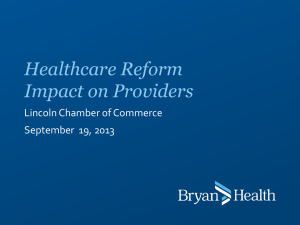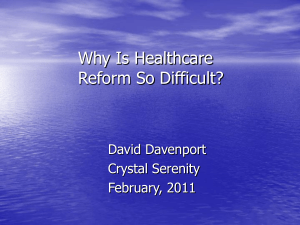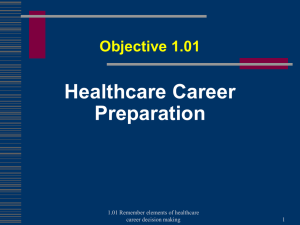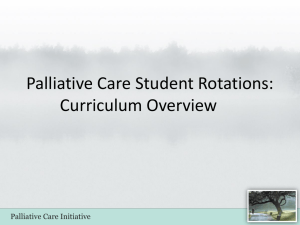Futurescan 2013–2018 - American College of Healthcare Executives
advertisement
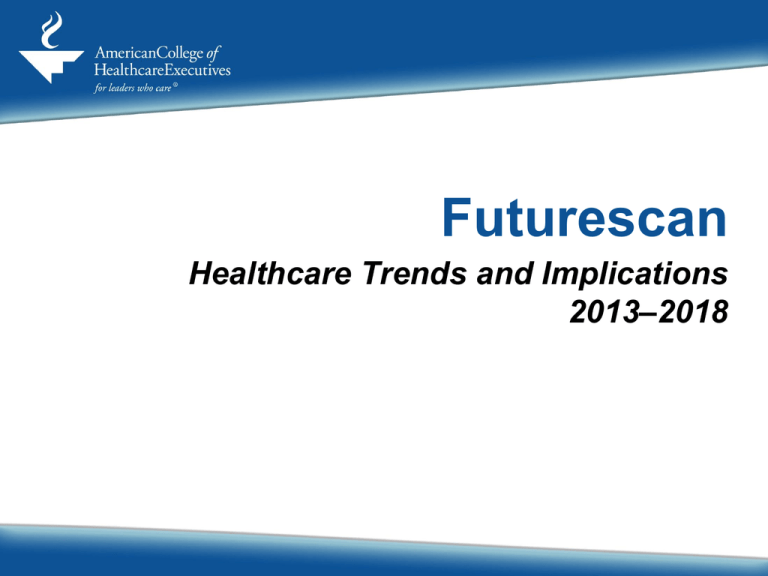
Futurescan Healthcare Trends and Implications 2013–2018 Futurescan Co-sponsored by: • Society for Healthcare Strategy and Market Development of the American Hospital Association • American College of Healthcare Executives • With Support From VHA Inc. 2 American College of Healthcare Executives • Professional society of more than 40,000 healthcare executives—Leaders Who Care • Board certification in healthcare management as ACHE Fellows (FACHE®) • Foremost continuing educator for the field • Leading healthcare management publications: – Health Administration Press books – Journal of Healthcare Management, Frontiers of Health Services Management and Healthcare Executive • Fulfilling our vision to be the premier professional society for healthcare executives dedicated to improving healthcare delivery 3 Society for Healthcare Strategy and Market Development • Personal membership group of the American Hospital Association • Serves more than 4,000 healthcare planning, marketing and public relations/communications professionals • Committed to helping members meet the future with more knowledge and opportunity as their organizations work to improve health status and quality of life in their communities 4 Futurescan 2013–2018 • Insurer-Provider Integration: Insurers and Providers Integrating Toward a Common Cause • Value-Based Payment: The Calculated Risk of Payment Reform • Nursing: Transitions in Nursing Present Challenges and Opportunities for Hospitals • Palliative Care: Better Care for the Seriously Ill, Better Value for the Healthcare System Please note that the views expressed by the conference speakers do not necessarily reflect the views of the Center for Healthcare Governance and the American Hospital Association. 5 Futurescan 2013–2018 • Information Technology: Health Information Exchanges—Helping Hospitals Harness the Power of IT • Mobile Healthcare: mHealth and the Future of Healthcare • Governance: A Transforming Healthcare Sector Requires Boards to Step Up Their Game • Striving for Excellence: The Future of Baldrige-Based Performance Excellence Please note that the views expressed by the conference speakers do not necessarily reflect the views of the Center for Healthcare Governance and the American Hospital Association. 6 “The hospital—altogether the most complex human organization ever devised …” Peter Drucker Drucker, Peter F. (2002). Managing in the Next Society. New York, New York: St. Martin’s Griffin. 7 Actions We Should Start, Stop and/or Continue We should start..... We should continue..... We should stop..... 8 FutureScanning Trend Implications of this Trend? Implications of this Trend? Implications of this Trend? Implications of this Trend? Implications of this Trend? At least 1 positive, and 1 negative. Implications of this Trend? 9 Insurer-Provider Integration Insurers and Providers Integrating Toward a Common Cause Scott P. Serota 10 Insurer-Provider Integration: Aligned Incentives Mean Better Results Integration of providers and insurers can align incentives to better control costs. • Learn from past missteps but recognize that today’s environment has changed. • Closely monitor the development of new federal and other aligned payment strategies. • Be aware that physicians may need assistance in adjusting to new payment mechanisms. 11 Insurer-Provider Integration: Collaborative Strategies Hospitals and insurance companies will form joint ventures to create new insurance products. • Take steps to learn more about the insurance industry culture, values and operations. • Design products and strategies that serve consumers who are demanding more involvement in their health and medical care. • Consider products that will target high-end consumers. • Prepare IT systems to handle more sophisticated analytics to monitor new strategies. 12 Insurer-Provider Integration: Aligned Practice Health plans will share risk with providers through patient-centered medical homes, ACOs and other new organizational structures. • Build capacity in primary care. • Monitor the progress of the organizations participating in the CMS ACO programs. • Educate staff and board members about the benefits and risks of aligned practices. • Build needed IT capacity and sophistication. 13 Insurer-Provider Integration: Paying for Value not Volume New reimbursement strategies will better align financial incentives between providers and insurers. • Make sure data systems can effectively track quality indicators and not just volume. • Make sure data systems can track patients through the entire care experience and not just in the hospital. • Keep up to date with new payment strategies being piloted by private insurers. • Be cognizant that consumers will be demanding greater value. 14 Insurer-Provider Integration: Public and Regulatory Pressures The passage of the ACA has cast the public spotlight on many healthcare issues that were previously ignored. • Be prepared to assume a broader and more visible community role. • Focus more attention on population health and community benefit. • Tighten cost structures as the shifting of costs from public to private sources will no longer be tenable. • Be prepared to be transparent in terms of costs and quality. 15 Value-Based Payment The Calculated Risk of Payment Reform Bruce S. Pyenson 16 Value-Based Payment: Insurers Are Poised for Change Forced to abandon many traditional practices (e.g., lifetime limits, exclusion of pre-existing conditions), insurers will look for new models for handling risk. • Closely monitor the insurance industry in your area so you will be able to respond quickly to changes. • Consider joint ventures with insurers to create new products. • Design programs aimed at health promotion. • Design programs that will reduce 30-day readmissions. 17 Value-Based Payment: Payments Will Be Less Inpatient admissions will decrease over the next several years. • Focus on outcomes, quality and access rather than volume. • Expect a decrease in elective procedures as cost sharing increases. • Develop centers of excellence to capture the more limited volume of elective procedures. 18 Value-Based Payment: A Spectrum of Potential Responses Payment reform will present opportunities that involve risk and will require new ways of evaluating potential outcomes. • Think beyond the status quo when evaluating new opportunities. The status quo may be disappearing. • Use scenario planning to evaluate opportunities against current and future opportunities. • Plan for costs associated with learning new strategies and ways of operating. 19 Value-Based Payment: Focus on Outcomes The majority of new payor contracts will be performance based. • Create care management teams that will follow patients after discharge. • Work with the medical staff to help them transition to the new reimbursement environment. • Consider participating in bundled payment programs. • Closely monitor ACO developments in your area. 20 Value-Based Payment: Human Capital Needs Hospitals will need a depth of financial, medical and administrative talent to succeed at payment reform. • Consider hiring executive-level staff with experience in the insurance industry. • Develop medical leaders who can relate administrative excellence to clinical outcomes. • Develop finance staff who understand risk assessment and management. • Look for leaders with experience in alternative forms of reimbursement. 21 Nursing: Transitions in Nursing Present Challenges and Opportunities for Hospitals John W. Rowe, MD 22 Nursing: Expanding Scope of Practice Many states will pass legislation allowing advanced practice nurses to practice independently. • Carefully monitor the situation in your state and provide appropriate advocacy. • Investigate ways that advanced practice nurses can collaborate with primary care physicians in your facility. • Look for ways that advanced practice nurses can extend your primary care capabilities. • Work with medical and nursing leadership to allow nurses to practice to the full extent of their training as the law permits. 23 Nursing: More BSNs Hospitals will hire more BSN-prepared nurses who are better equipped to handle the increasingly complex care setting. • Work with local nursing schools to develop programs to create pathways for practicing nurses to earn the BSN degree while employed. • Work with local nursing schools to develop simulation labs and clinical experiences to expand the number of training slots. • Provide tuition assistance for employed nurses earning a BSN degree. 24 Nursing: Magnet Status as a Sign of Excellence More hospitals will pursue Magnet status as a means of gaining market advantage. • Assess the benefits and costs of obtaining Magnet status at your institution. • Work with local BSN programs to recruit their graduates, as Magnet status emphasizes this degree. • Work with local colleges to provide pathways for current nurses to pursue a BSN degree while employed. • Use the Magnet application as a means of improving and promoting excellent nursing care. 25 Nursing: Nurse Residency Programs Residency programs will proliferate in order to better prepare the nursing workforce and improve retention. • Work with local nursing schools to create residency programs in your facility. • Use residency programs as a means of recruiting and retaining well-qualified nurses. • Use residency programs as a way of engaging and stimulating nursing staff. 26 Nursing: Clinical Nurse Leaders Clinical nurse leaders will be used to direct care teams that promote evidence-based medicine and quality care. • Provide mentoring and leadership opportunities for nurses with graduate-level training. • Provide financial incentives or scholarships for promising BSN-level nurses to pursue advanced degrees. • Be sure your organization’s CNO is a full participant on the leadership team. • Consider adding an individual with a graduate degree in nursing to your governing board. 27 Palliative Care: Better Care for the Seriously Ill, Better Value for the Healthcare System Diane E. Meier, MD 28 Palliative Care: A Standard Service Line Palliative care will be a regular feature of integrated care and will be offered by virtually all large organizations. • Train your workforce in palliative care competencies. • Develop palliative care interdisciplinary teams that can coordinate care for seriously ill patients. • Make sure the individuals responsible for innovation or development add palliative care to their priorities. • Seek Joint Commission certification for your palliative care program in anticipation of a likely future accreditation requirement. 29 Palliative Care: Avoiding Unwanted and Costly Care Palliative care programs will reduce costs by decreasing ED visits and re-hospitalizations, and by helping patients and families make more informed care decisions. • Make sure staff throughout the facility are aware of the palliative care program. • Recruit physicians who have subspecialty certification in hospice and palliative medicine. • Recruit non-physician staff who have specialized training and expertise in palliative care techniques. • Make sure the palliative care team comprises the appropriate mix of caregivers. 30 Palliative Care: Better Care By providing a coordinated approach, palliative care programs improve the quality of care given to seriously ill patients. • Educate the community on the value of palliative care. • Emphasize the support patients receive in navigating the healthcare system. • Develop and monitor quality indicators that reflect the value of palliative care programs. • Develop an organizational structure that allows for the identification of palliative care candidates throughout the organization. 31 Palliative Care: New Skills for Physicians Medical school and residency training will require that physicians demonstrate competency in palliative care skills. • Provide continuing education for current staff physicians in palliative care skills and encourage subspecialty certification. • Make sure staff physicians understand the value palliative care can have for patients and families. • Recruit physicians who are certified in hospice and palliative care. 32 Palliative Care: It Takes the Community In the long term, palliative care programs will be integrated with community resources outside the acute-care setting. • Conduct a palliative care systems capacity assessment in concert with community agencies. • Develop relationships with local nursing homes, home health services, assisted living facilities and other community agencies. • Develop management expertise that can effectively share resources with community partners. 33 Information Technology: Health Information Exchanges— Helping Hospitals Harness the Power of IT Carla Smith John P. Hoyt, FACHE Pamela Matthews, RN 34 Information Technology: More Cost-Effective Care and Payment Hospitals’ adoption of electronic data interchange (EDI) standards will accelerate in order to reduce costs. • Make sure the IT department can capture data from a variety of software applications. • Make sure the strategic plan addresses EDI and its relationship to other initiatives. • Design systems for addressing standards that streamline processes. • Use funds saved from clearinghouse fees for other strategic IT initiatives. 35 Information Technology: A Key Tool for Delivering Care Electronic data interchange will be a key tool in the delivery of care and in payment models. • Plan carefully in designing and implementing systems for EDI. • Tie EDI to the organization’s strategic plan. • Understand that data is a strategic lever for operational efficiency and providing quality care. • Be prepared to invest the necessary resources in these systems. 36 Information Technology: “Homegrown” Health Information Exchanges Many hospitals will develop their own health information networks in order to most effectively manage costs and coordinate care. • • • Carefully evaluate your organization’s capabilities for designing and operating its own HIE. Build and invest for the long term, both in terms of intelligence systems and staff competence. Continue to monitor public and other private HIE efforts in the community. 37 Information Technology: Community and State Health Information Exchanges Local communities or states will pool their resources to construct health information exchanges that serve a variety of organizations and settings. • Closely monitor all public and private HIE efforts in your community. • Be cognizant of the various funding sources (e.g., grants to participant fees) for community HIEs. • Be prepared to devote resources to an HIE. • Develop an IT strategic plan that addresses local, state, federal and payor-based initiatives for the integration of clinical and business data. 38 Information Technology: Integrating Health Resources Health networks and information technology will be the mechanism to integrate care across multiple providers and enable population health management. • • • Carefully evaluate your organization’s current and future IT capabilities. Hire clinical staff with expertise in data analytics. Build relationships and partnerships that will be key to your organization’s future success. 39 Mobile Healthcare: mHealth and the Future of Healthcare Christopher L. Wasden, EdD 40 Mobile Healthcare: Inevitable and Transformative Mobile technology will have widespread applications in healthcare and will transform how care is delivered. • Make sure you have a viable strategy for mHealth and its applications. • Hire staff who are expert in mobile applications. • Focus on interoperability between applications. • Monitor other industries in order to anticipate new demands by patients and other stakeholders of mHealth. • Make free Wi-Fi available throughout your facility. 41 Mobile Healthcare: Preventing Readmissions Remote monitoring systems will reduce readmissions and ED use by patients with chronic conditions. • Consider providing low-cost or free home monitoring services, as they can reduce overall costs. • Use social media to provide support and assistance to discharged patients. • Closely monitor the medical device industry for new applications in mHealth. 42 Mobile Healthcare: New Dimensions in Patient-Physician Relations Mobile technology will transform and expand the traditional patient-physician relationship. • Encourage physicians to communicate with patients via email or text. • Help physicians create new payment models for mobile communications. • Take appropriate steps to safeguard the security and confidentiality of patient information. • Make sure physicians have easy access to wireless technology throughout your facility. 43 Mobile Healthcare: A More Engaged Patient and Consumer Patients will use mobile technology to monitor their health and engage in healthy behaviors. • Provide access to health apps with demonstrated effectiveness through your website and promotional materials. • Design apps that provide information on healthy eating and activities that promote health. • Provide virtual health coaching services for individuals or groups using mobile technology. 44 Mobile Healthcare: On Demand Medicine and Healthcare Patients will expect to schedule appointments on mobile devices and to access test results as soon as they are entered into their EHR. • • • • Develop online scheduling protocols. Develop secure channels and the necessary security safeguards so patients have the ability to access their EHRs remotely. Help physicians develop procedures for sharing patient data via mobile devices. Acknowledge that healthcare will become increasingly transparent. 45 Governance: A Transforming Healthcare Sector Requires Boards to Step Up Their Game Barry S. Bader 46 Governance: Leaner, More Efficient Structures Economic pressures for greater operational efficiency will lead systems to consolidate or eliminate local subsidiary boards. • Examine the various types of board models to determine which best meets your needs: professional, clinical expertise or community based. • Choose system board members based on desired skills and the ability to pursue the interests of the entire system. • Find new roles for former members of local boards so their commitment and dedication is acknowledged and extended. • Look for new ways to connect local units or facilities with the communities they serve. 47 Governance: Higher Expectations for Board Performance As hospitals transform into care systems, boards will need to evolve to meet the more complex needs of the future. • Select board members based on the skills and expertise they bring as well as their ability to be strategic and visionary. • Set clear standards for board members’ attendance and participation. • Provide the necessary continuing education to keep board members up to date on the rapid changes in the field. • Make sure the board engages in a regular and rigorous self-assessment process. 48 Governance: New Ways of Operating Boards will need to adopt leadership strategies that will enable them to transform their organizations in an uncertain environment. • Employ scenario-based strategic planning to address “what if” questions. • Make decisions based on inquiry and empirical data rather than advocacy. • Use dashboards and scorecards so boards can easily monitor performance and identify variance. • Focus on both short-term performance and longer-term growth and evolution. • Use risk management techniques to assess various types of risk—reputational to financial. 49 Governance: A Focus on Quality Boards will elevate quality from an oversight function to a strategic priority that is integral to system redesign and cultural transformation. • Devote at least 20% of meeting time to quality issues. • Include quality objectives in the CEO’s performance evaluation. • Work with medical staff to set quality and patient safety goals. • Include at least one independent quality expert as a board member. 50 Governance: More Public Accountability Boards will devote more attention to their public accountability for community benefit, stewardship of resources and ethical conduct. • Advocate for clear and consistent regulatory requirements for tax-exempt status. • Educate board members on how to use community health assessments in strategic planning. • Structure boards to give high priority to community benefit and community health improvement initiatives. • Build capacity for collaboration with appropriate community partners. 51 Governance: Changing Roles for Physician Board Members As physician-hospital integration progresses, physician board members will face conflicts of interests as employees or competitors. • Use the same competency-based criteria to select physician board members. • Look for new ways to involve key physicians in the operation and direction of the hospital. • Consider developing a clinical leadership infrastructure that can be used to channel the voice of physicians to the governing board. 52 Striving for Excellence: The Future of Baldrige-Based Performance Excellence Harry S. Hertz, PhD, HFACHE 53 Striving for Excellence: The Baldrige National Quality Award • Established in 1988, Baldrige is the only U.S. public-private partnership dedicated to improving U.S. organizations so they can compete globally. • The Baldrige Award program broadened in 1998 to include healthcare and education organizations. • There have been 16 winners in the healthcare category since the program’s inception. 54 Baldrige Healthcare Criteria Framework: A Systems Perspective Source: Baldrige Performance Excellence Program 55 Striving for Excellence: Baldrige Goals Healthcare organizations’ interest in the Baldrige Award will remain high. • Benchmark your organization’s capabilities and performance against the Baldrige criteria. • Use the criteria to achieve the type of organizational excellence necessary for success in the current environment. • Participate in state-level quality award programs. • Encourage key staff to participate in Baldrige or local quality programs as examiners. 56 Striving for Excellence: A Holistic Approach Healthcare organizations will use a holistic approach to achieve organizational excellence and efficiency. • Use the seven Baldrige criteria as an internal assessment tool. • Determine if measurements are in place to monitor performance in all key areas. • Make sure your information system can effectively integrate clinical and nonclinical functions when assessing performance. • Use both historical and external measures to benchmark organizational performance. 57 Striving for Excellence: Integrated Strategies Healthcare organizations will adopt integrated strategies for safety, quality and cost reduction. • Make the application of quality tools a standard part of operations. • Use the Baldrige framework as a means to focus attention on each of these essential elements of care. • Be sure your organization uses “cycles of learning” so measurements are monitored and then used to improve performance. 58 Striving for Excellence: Social Media as the New Frontier Future Baldrige criteria will acknowledge the role of social media in organizational excellence. • Use social media to communicate with staff and break down traditional organizational barriers. • Use Facebook, Twitter and other social media outlets to communicate with consumers. • Use social media to coordinate with suppliers, collaborators and other external partners. • Use data from social media exchanges to learn about customers’ preferences and perceptions. 59 Striving for Excellence: Focus on Business Model Innovation Constant innovation will be necessary to achieve performance excellence in a transformed healthcare system. • Expect that innovative practices will be incorporated into future Baldrige criteria. • Incorporate innovation and entrepreneurship into leadership development programs. • Use experts from outside the industry to seed ideas for disruptive changes. • Select board members who can offer creative strategies beyond the traditional “hospital focus.” 60 “‘We will do everything for everybody’ has never been a viable value proposition for any successful business model that we know of—and yet that’s the value proposition … of general hospitals.” Clayton M. Christensen, Jerome H. Grossman, MD, and Jason Hwang, MD The Innovator’s Prescription: A Disruptive Solution for Health Care (2009) 61 Futurescan This presentation was adapted by Mary Stefl, PhD, Chair, Health Care Administration, Trinity University, from Futurescan: Healthcare Trends and Implications 2013–2018. Futurescan 2013 is available for purchase from Health Administration Press. Single copies (order code 2236) are $48. Packages of 15 copies (order code 2243) are available for a discounted price of $430. Order online at ache.org/HAP or call the ACHE/HAP Order Fulfillment Center at (301) 362-6905. 62 Futurescan Healthcare Trends and Implications 2013–2018
